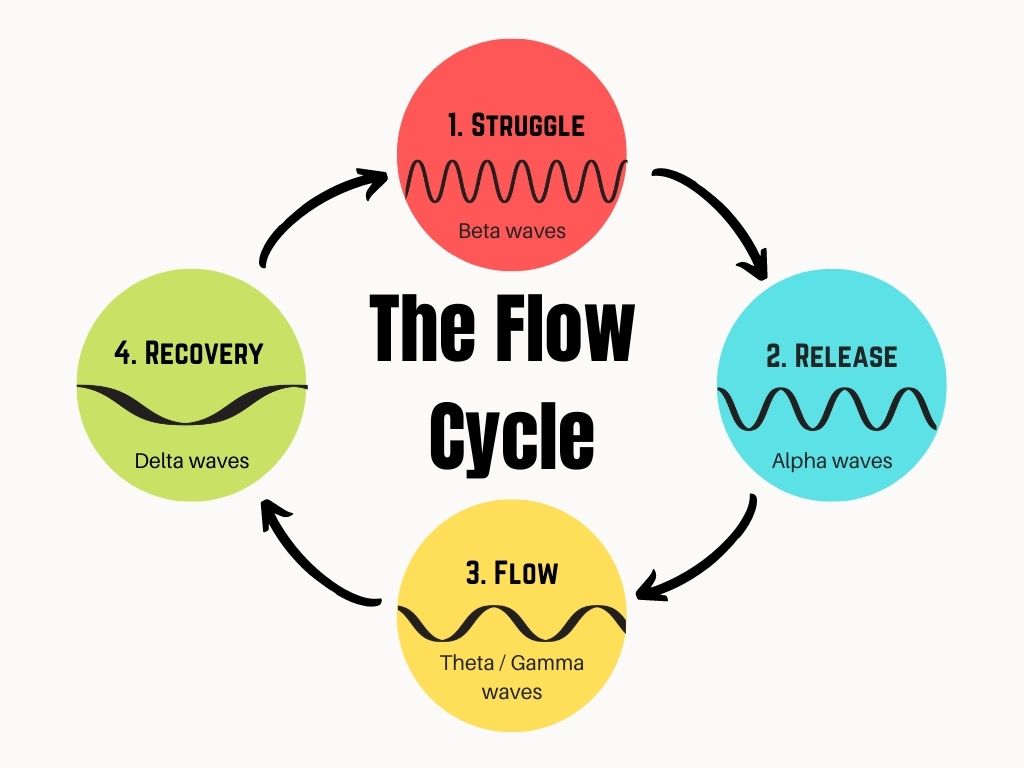Flow is one of those experiences that people want more of in their lives, and given its growing popularity and the research going into it, that seems like a reasonably achievable feat.
People are slowly moving away from the 9 – 5 workday routine, the idea of the workaholic is dying. And rightfully so, as Andrew Smart notes in his book Autopilot, we’ve been in an age of “idlephobia” in which we can’t stand doing nothing. The distant past wasn’t like this, his hope is that the future won’t be either.
“Confucianism actually disdained hard work and instead idealized leisure and effortlessness.” — Andrew Smart, Autopilot
Now, we’re finding new ways to be productive, we’re producing both quality and quantity using not time, but science.
Through studies, we now know that 80 percent of our output comes from only 20 percent of the effort. Clearly, the people who can take advantage of this 80:20 rule — known as the Pareto principle — will get more done in less time. We’ve also used science to help us master the art of goals, habits, and time-management.
We know how to use the Pomodoro technique, and we know not to multitask; we know that we need time to relax either through meditation or another means, and we know that sleep, good food, and exercise are essential to a healthy mind that performs at its peak.
All of these things are making their way into the workplace, but they are all basically additives to the job at hand, they themselves don’t motivate us, especially if we don’t enjoy the work, and motivation is the most important factor.
In our jobs, we now demand a greater purpose, the ability to grow, and control over how we do it. Together these elements form the 3 pillars of intrinsic motivation (autonomy, mastery, and purpose). In creative knowledge-based work, these factors are often more effective motivators than monetary or status gains.
Flow is another of these now well-documented boosts. In this state, our distractibility diminishes as we become one with the task, motivation flourishes through self-determination and focus, time loses meaning and all that remains is what we want to achieve. While the physical and mental acts involved during these moments of flow might be difficult, exhausting, or even painful, what people are left with is anything but negative, in fact it’s one of the most sought-after experiences there is.
Mihaly Csikszentmihalyi detailed several important conditions we need to meet to experience flow. Now I’d like to add something: Self-talk. What we say not to other people, but to ourselves.
In Conversation With Yourself
Those inner conversations, be they automatic or volitional, negative or positive, motivational or instructional, have a great deal to do with both our happiness and our performance.
Most people know about the harsh automatic negative self-talk, we’ve all at some point fallen victim to some blame or self-doubting words. For many, the answer is to acknowledge that these thoughts don’t belong to us, and perhaps to try a form of mindfulness or another practice to reduce them.
But I believe that in a way they are us, they (we) have just gone astray. One problem lies in them being automatic, in which case the negativity may stem from a deeper concern in the same way as rumination and troubled daydreaming, but that’s not my place to say.
My solution is not to eliminate self-talk, but to take control of it, if it is indeed “us,” then certainly we can choose to say what we want. Even if that’s not the case, it’s hard to listen to two conversation streams at once, so if you’re busy saying positive things, it’ll be harder to take any notice of the negatives.
“Nothing in life is as important as you think it is when you are thinking about it.” — Daniel Kahneman, Thinking Fast and Slow
One reason I believe that these thoughts are at least to an extent “us” is that research has shown that those who lose the ability to talk to themselves, a disability known as aphasia, lose their sense of self.
There several types of self-talk, that I mentioned above: Automatic or volitional, and positive or negative. Let’s focus on the positive.
It might not be too obvious, considering we’ve likely talked to ourselves in the same way for as long as we can remember, but there are many different ways we could do this.
For example, we could be motivational or instructional — giving undivided support and pushing ourselves to go further, or an offering of tips, techniques, and advice for overcoming different obstacles. Another distinction is in whether that voice is in third-person or first-person — do you talk to yourself using “I” or “you”? Of course, we might often use a combination.
Talking Your Way To Flow
A number of studies have examined the precursors to flow in athletes, and positive self-talk shows a strong correlation.
There is not a big difference between whether it was instructional or motivational, both forms of positive self-talk aided flow, yet the most effect was, in fact, a combinatorial style.
“The ‘autotelic self’ is one that easily translates potential threats into enjoyable challenges, and therefore maintains its inner harmony.” — Mihaly Csikszentmihalyi, Flow: The Psychology of Optimal Experience
The benefits of either instructional or motivational depended on the nature of the exercise: if the activity involved fine movements or detailed steps the instructional style helped more; while activities where willpower, brute strength or endurance were needed the motivational style worked better.
Notably, those who used the motivational style reported that they had more confidence, they felt stronger, and had a greater ability to concentrate.
That ability to concentrate is what will help boost flow.
As Mihaly mentions, a personality that turns threats and difficulties into challenges ripe for overcoming is one that will achieve flow and inner harmony. In wanting to attack these challenges, it makes sense to spur ourselves on with the motivational style, while the added benefit of the instructional style aids us in those tasks that contain complexity.
Pick Your Viewpoint
Self-talk is not limited to being a confidence booster or as an aid to focus and flow, it can also alter our perceptions of ourselves and the world around us. An article on NPR says it might “be more like internal remodeling.”
There is some recent evidence that using “I” when talking to yourself could cause more stress than using “you” or your own name.
“I wanted to do what was best for LeBron James.” — LeBron James
Psychologist Ethan Kross of the University of Michigan studied participants as they used both forms while preparing for a speech, and found that the people who used the third-person “you” or their own names sounded more rational and less emotional.
Speaking to yourself in third-person creates distance. Just as people practice meditation to get away from heated emotional reactions, it appears the same effect can be had by altering the way we talk to ourselves.
You might have noticed that it can be easier to give others advice than to give it to yourself, or perhaps you can see a situation or argument more clearly when you’re not one of the people involved. The same idea applies here, by using the third-person voice you gain clarity, you can see things objectively.
By using the motivational style we boost our confidence, strength, and focus, which makes us more likely to enter flow. Coupling it with instructional talk will help us deal with complexity. Using the third-person perspective will keep our heads clear and our views objective, helping us to avoid resorting to rash emotionally driven decisions.
It’s something often taken for granted, each of us talks to ourselves all throughout the day, perhaps now is a good time to start looking into how you do it, and what could change to make that voice more supportive.
- 5 Powerful Mental Models To Help You Navigate a Complex World - January 3, 2022
- Rapid Skill Acquisition: Autodidactism And Meta-Learning As A Skill - May 28, 2021
- The 7 Best Online Learning Platforms For Career Development - May 27, 2021





 This website uses cookies to improve your web experience.
This website uses cookies to improve your web experience.